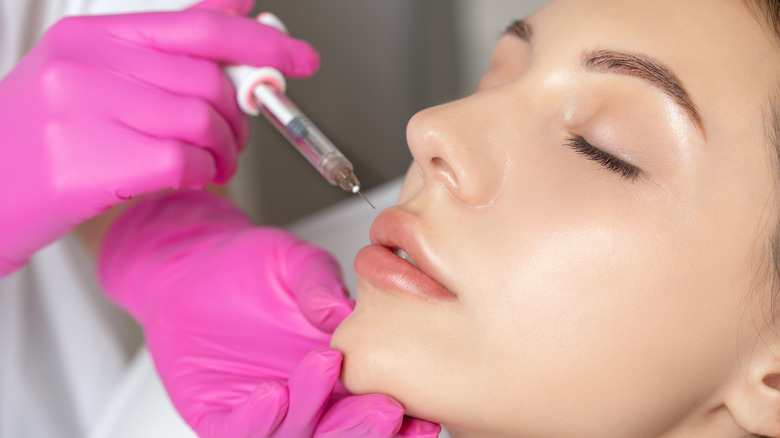What Is 'Lip Tenting,' And How Long Does It Last?
Have you ever considered getting lip injections but thought back to someone's botched job and changed your mind? You're not alone. A properly-done lip job may or may not attract attention, but a botched one is hard to ignore. Botched lip jobs are pretty common because the proper injection technique for lip fillers is tricky.
The injector has to inject the fillers into the vermillion border — the outermost rim of your lips. This technique is problematic for many reasons, including how weak the vermillion border is. Dr. Tom van Eijk, one of the most experienced cosmetic doctors in the world, dislikes this technique for reasons he stated in a 2020 "How I Do It" paper published in the PMFA Journal.
Eijk explains that vermillion border fillers are "prone to displacement" and create a possibility for the patient to develop the dreaded "duck lips." These flaws prompted him to design a better technique — lip tenting.
Lip tenting focuses on the white roll
Before we get started, it's important to identify your white roll — a line of lighter skin that rims your vermillion border and is prominent on the upper lip. The lip tenting technique focuses on this area and injects into the weakened pores to hold the lips up like poles hold a tent.
Lip tenting is best done on the white roll because it is stronger than the vermillion border and allows the injector to trace the lip's outline. An experienced injector will place the filler deeper into the skin, which gives the lips a full and outlined look. Since the filler is placed in tiny deposits, you can expect anywhere from 40 to 60 punctures. Lip tenting preserves the natural youth of your lips without drastic changes. In other words, it won't exaggerate your features but can enhance, redefine, and strengthen them.
One other reason for lip tenting's growing popularity is its lifespan. Dermatologist Dendy Engelman explained to PopSugar that the injections last 12 to 18 months and require checkups every six. These numbers beat the vermillion border method's 6-to-18-month average. Lip tenting also reduces the chances of displacement since the injection sites are deeper and stronger.
Lip tenting might not be for everyone
Before you book that appointment with an injector, you should know that lip tenting isn't for everyone. If you've had fillers before, especially if they were in your vermillion border, you might not get great results. Lips with no fillers are clean slates, making it easier for the treatment to be administered accurately.
Another vital thing to know is that lip tenting is more painful. This is because multiple deep injections will be spread across such a small site. Before your surgery, your doctor will use local anesthesia to numb the site, but you can expect to be sore afterward. You should also expect to experience lip filler swelling, which lasts a week or two.
Finally, remember that your lip job can only be as good as your injector and the products they use. Doctor Ejik recommends using hyaluronic acid fillers because they are soft, safe, and long-lasting. When picking out your doctor or injector, ensure they are licensed, registered, and have a proven record of success. Botched lip jobs are notoriously difficult to fix and even life-threatening, so avoid quack doctors that could give you duck lips.


